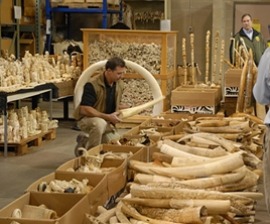On January 11, 2014, the Dallas Safari Club auctioned off a permit to hunt a black rhino in Namibia. The winner paid US $350,000. The black rhino is a critically endangered species, facing an extremely high risk of extinction in the wild. About 1,700 black rhinos live in Namibia and fewer than 5,000 exist in the world.
Q: The Dallas Safari Club says the US $350,000 will go to rhino conservation. Is that true?
A: There is no guarantee that the money will be used to conserve black rhinos. It will go to Namibia’s “Game Products Trust Fund,” a general pot of money allocated to all manner of projects—including those that have nothing to do with rhinos, and, in fact, could even be harmful to rhinos, such as “rural development.” The group that decides which projects will be funded is, comprised of diverse interests including community representatives, and Ministries of Agriculture and Finance.
It’s not too late. Urge the U.S. FWS to deny a rhino trophy import permit.
Q: Does killing one male black rhino harm the survival of the species?
A: Yes. The survival of critically endangered species depends on maintaining genetic diversity. The removal of even one rhino will remove that individual’s future genetic contribution to the population, thus reducing genetic diversity. This increases the extinction risk for the species.
Q: But I thought the rhino to be killed is old, no longer fertile, “post-reproductive,” and therefore “surplus.”
A: No, that is not true. Old, sick rhinos are not the ones trophy hunters want to kill; they want to kill a rhino in his prime. And the rhino targeted to be killed, while older, is dominant. Like a lot of mammals, male rhinos fight one another to achieve and maintain dominance. Male rhinos continue to breed throughout their lives until they become too old and sick to maintain their dominance.
Q: The DSC says the rhino to be killed is dangerous to other rhinos, or a “rogue.” Is that true?
A: Black rhinos fight one another to achieve and maintain dominance—it’s a natural behavior that ensures the fittest males will breed, thus enhancing the genetic fitness of the species as a whole and ensuring its continued survival.
Q: What does killing the fittest male mean to the future survival of the species?
A: Nature has created a mechanism to ensure that the most fit male black rhinos rise to dominance and pass their fit genes onto the next generation. If these rhinos are killed and prevented from continuing to pass their fit genes along, the species weakens and becomes more susceptible to extinction.
Q: How much money would a hunter need to contribute to Namibia to offset the killing of a black rhino?
A: No amount of money will offset the death of a member of a critically endangered species in terms of the survival of the species.
Q: Is it true that killing the older male black rhino will allow the black rhino population size to increase?
A: Black rhino populations can be manipulated to improve population growth rates. But this can be achieved without killing any members of the species. Black rhinos should be allowed to maintain their natural behaviors, including the ability of the fittest males to achieve and maintain breeding dominance, as this strengthens the genetic fitness of the species as a whole and ensures its continued survival. To do otherwise is a form of human domestication.
Please take urgent action to help and share on Facebook and Twitter to ask your friends to do the same. Then, please consider donating to help us stop wildlife abuse.







